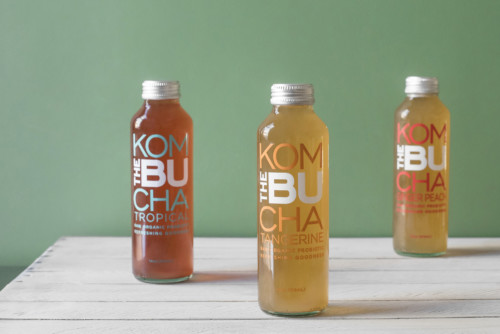
Think You Don’t Like Kombucha? You Haven’t Tried The Bu.
Think you don’t like kombucha? Think again. While many new-age kombucha brands tout the benefits of drinking kombucha– namely, by claiming that it is a rich source of health-boosting probiotic gut flora– most of them also taste like vinegar, with a harsh acidity that alienates many people who “want” to like kombucha but can’t seem to the handle the taste. Enter The Bu Kombucha— a new company that is changing up the paradigm with a light, refreshing line of approachable kombuchas that pack all the health benefits of the beverage without the drawbacks in flavor or mouthfeel.
The Bu’s proprietary kombucha blends come in flavors like Lavender, Chai Spice, and Honeydew (more nuanced notes than the typical “Ginger-Apple” combos that can be found at most groceries around the country) and the drink itself has negligible sugar; unlike most kombuchas, The Bu’s get their flavor from fermented tea, rather than cane sugar. Gary Hawes, brew master for the company, says that even the probiotic formulations are curated with precision: “We’ve been growing the same cultures that I developed in Hawaii years ago,” he says, noting that he developed a good balance of yeasts and probiotic bacteria through experimentation, he found a “relatively high glucobacter/acetobacter ratio” that led to the balanced flavor that fans of the brand love. (We really like the Lavender one.)
So what does it take to brew kombucha on such a large scale? “We have massive SCOBYs,” quips Hawes. “I pulled out a 200 pounder once!”
“It was quite an operation, so we don’t let them get that big any more, but they will get as big as the container they’re in… If I fermented in a swimming pool that’s how big the SCOBY would be!” (SCOBYs, for the uninitiated reader, are a Symbiotic Culture of Bacteria and Yeast– aka SCOBY– which form a zoogleal mat known as a ‘mother’. To make kombucha, one must add tea or juice and a little water to a container along with a SCOBY to ferment the elixir into kombucha– a process that imbues the liquid with probiotic cultures that make it healthy for the human gut.)
“Temperature is important,” Hawes continues. “Too cold and the fermentation will stop; too warm and the taste gets sharper due to the bacteria growing faster than the yeast. Each have a optimal temperature, our yeasts like it cooler. Knowing how to balance all the factors involved and adjusting on the fly if necessary [is key]. Even though we use the same recipes, kombucha is a living beverage and is constantly changing; every batch is a little different due to fluctuations in temperature, culture growth rates, starter characteristics, etcetera. We try to keep each flavor as consistent as possible, the challenge is to manage hundreds of different organisms and billions of bacterial and yeast cells and have a consistent end product that tastes like it should!”
“Health codes,” Hawes adds, “don’t deal with temperature and humidity as much as food safety– like cleanliness, good manufacturing practices, etcetera. Luckily, kombucha has a low pH (2.9-3.1), which kills pathogens due to acidity– this makes contamination much less likely than in beer or winemaking. The only bacteria that like to grow in kombucha are the ones we want– it’s too harsh an environment for most other bacteria and yeast.”
So how does the Bu manage to produce a kombucha that doesn’t have the acidic taste and harshness of flavor that is typically associated with kombucha?
“It’s a combination of factors,” says Hawes. “One, the aforementioned culture with a optimal balance of bacteria and yeast. Two, premium raw ingredients, and three, closely monitoring the ferment and pulling it at optimal taste, before it gets harsh and vinegary.”
“Our business model has always been to make kombucha everybody can enjoy, so I developed our taste profiles accordingly. I was really having trouble choking down the vinegary stuff, so I had to start making my own!”
For more information on Bu Kombucha, visit the company’s website.



































